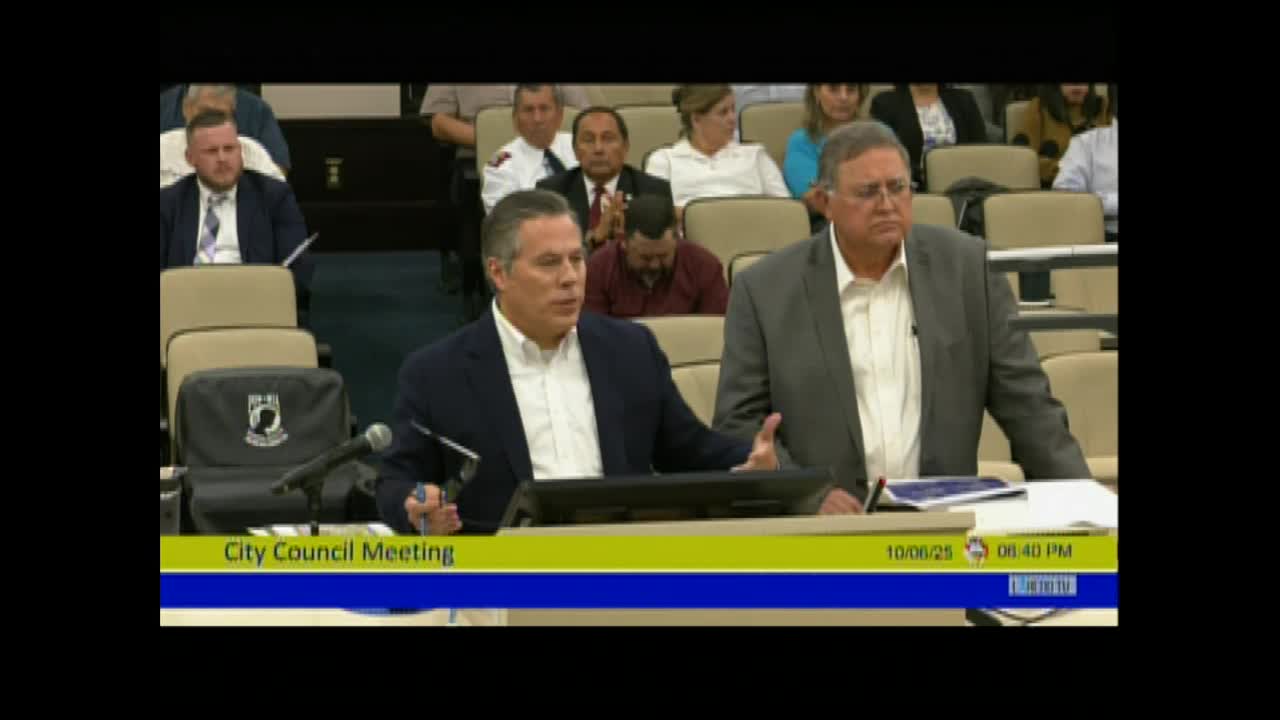Council creates a secondary-water task force as staff outlines long-term options, seeks regional partnerships
October 06, 2025 | Laredo, Webb County, Texas
This article was created by AI summarizing key points discussed. AI makes mistakes, so for full details and context, please refer to the video of the full meeting. Please report any errors so we can fix them. Report an error »

The Laredo City Council voted Oct. 6 to establish a staff-led secondary water task force to identify and pursue alternative water sources for the city, directing the city manager to appoint staff and provide quarterly status updates to the council.
Staff briefed council on the city’s current water position and short- and long-term options. City staff said the city currently consumes roughly 35 million gallons per day (MGD) and holds water rights that total about 55 MGD. Staff described several lines of activity already under way: private-sector-led groundwater efforts, ongoing memorandums of understanding (MOUs) with regional partners and exploratory work on reusing treated wastewater.
Why it matters: Laredo relies predominantly on the Rio Grande. Staff and council members said climate variability and downstream water demands make pursuing additional sources a long-term priority. The task force is intended to centralize city efforts and accelerate coordinated work with regional partners and state agencies.
Staff brief and key numbers
City staff (Dr. Elzebet, water resources) told council the city’s two treatment plants currently can produce significantly more than current demand; however, water-rights limits and source reliability pose longer-term constraints. Staff reported the city treats roughly 23 MGD of wastewater daily — a volume that could be considered for reuse projects that would reduce reliance on river withdrawals. Staff also summarized active private projects and regional discussions: a private entity known as Legacy is pursuing a large groundwater/water-rights program that could produce an estimated 5–6 MGD for participating customers (staff estimated that project’s funding and permitting path would likely take two to three years), and a separate regional scheme centered near Eagle Pass could offer larger volumes but at much higher cost and with longer timelines.
Council direction and timing
Council members emphasized both short-term contingency planning and long-range strategy. The council voted to create a staff-coordinated secondary-water task force, with staff appointments chosen by the city manager and with quarterly council briefings. Staff said they will continue to pursue MOUs and funding, coordinate with state agencies and prepare an action plan that identifies priority projects, timelines and funding pathways.
Ending
Staff noted that some options — groundwater development, desalination and treated-wastewater reuse — carry high upfront costs and multi-year timetables. The task force is intended to centralize analysis and move the city from reactive emergency response to a coordinated, multi-source water strategy.
Staff briefed council on the city’s current water position and short- and long-term options. City staff said the city currently consumes roughly 35 million gallons per day (MGD) and holds water rights that total about 55 MGD. Staff described several lines of activity already under way: private-sector-led groundwater efforts, ongoing memorandums of understanding (MOUs) with regional partners and exploratory work on reusing treated wastewater.
Why it matters: Laredo relies predominantly on the Rio Grande. Staff and council members said climate variability and downstream water demands make pursuing additional sources a long-term priority. The task force is intended to centralize city efforts and accelerate coordinated work with regional partners and state agencies.
Staff brief and key numbers
City staff (Dr. Elzebet, water resources) told council the city’s two treatment plants currently can produce significantly more than current demand; however, water-rights limits and source reliability pose longer-term constraints. Staff reported the city treats roughly 23 MGD of wastewater daily — a volume that could be considered for reuse projects that would reduce reliance on river withdrawals. Staff also summarized active private projects and regional discussions: a private entity known as Legacy is pursuing a large groundwater/water-rights program that could produce an estimated 5–6 MGD for participating customers (staff estimated that project’s funding and permitting path would likely take two to three years), and a separate regional scheme centered near Eagle Pass could offer larger volumes but at much higher cost and with longer timelines.
Council direction and timing
Council members emphasized both short-term contingency planning and long-range strategy. The council voted to create a staff-coordinated secondary-water task force, with staff appointments chosen by the city manager and with quarterly council briefings. Staff said they will continue to pursue MOUs and funding, coordinate with state agencies and prepare an action plan that identifies priority projects, timelines and funding pathways.
Ending
Staff noted that some options — groundwater development, desalination and treated-wastewater reuse — carry high upfront costs and multi-year timetables. The task force is intended to centralize analysis and move the city from reactive emergency response to a coordinated, multi-source water strategy.
View full meeting
This article is based on a recent meeting—watch the full video and explore the complete transcript for deeper insights into the discussion.
View full meeting
